Impact of Crowd-sourcing on the Clothing Industry: ITECH1100 Report
VerifiedAdded on 2023/04/26
|10
|1906
|216
Report
AI Summary
This report examines the impact of crowd-sourcing on the clothing industry, exploring its technological applications and influence. Part one presents research on crowd-sourcing and its benefits for the industry, including cost reduction and improved delivery speed. Part two delves into brainstorming, discussing technology's impact, parallels to other industries, and alternative technologies. Part three addresses regulations and ethics, evaluating them based on Lessig’s categories. Part four analyzes disruption, focusing on process factors, events, and outcomes. The report also includes process model diagrams illustrating crowd-sourcing implementation, and references to support its findings. This assignment fulfills the requirements of ITECH1100, exploring how technology can change a specific industry.
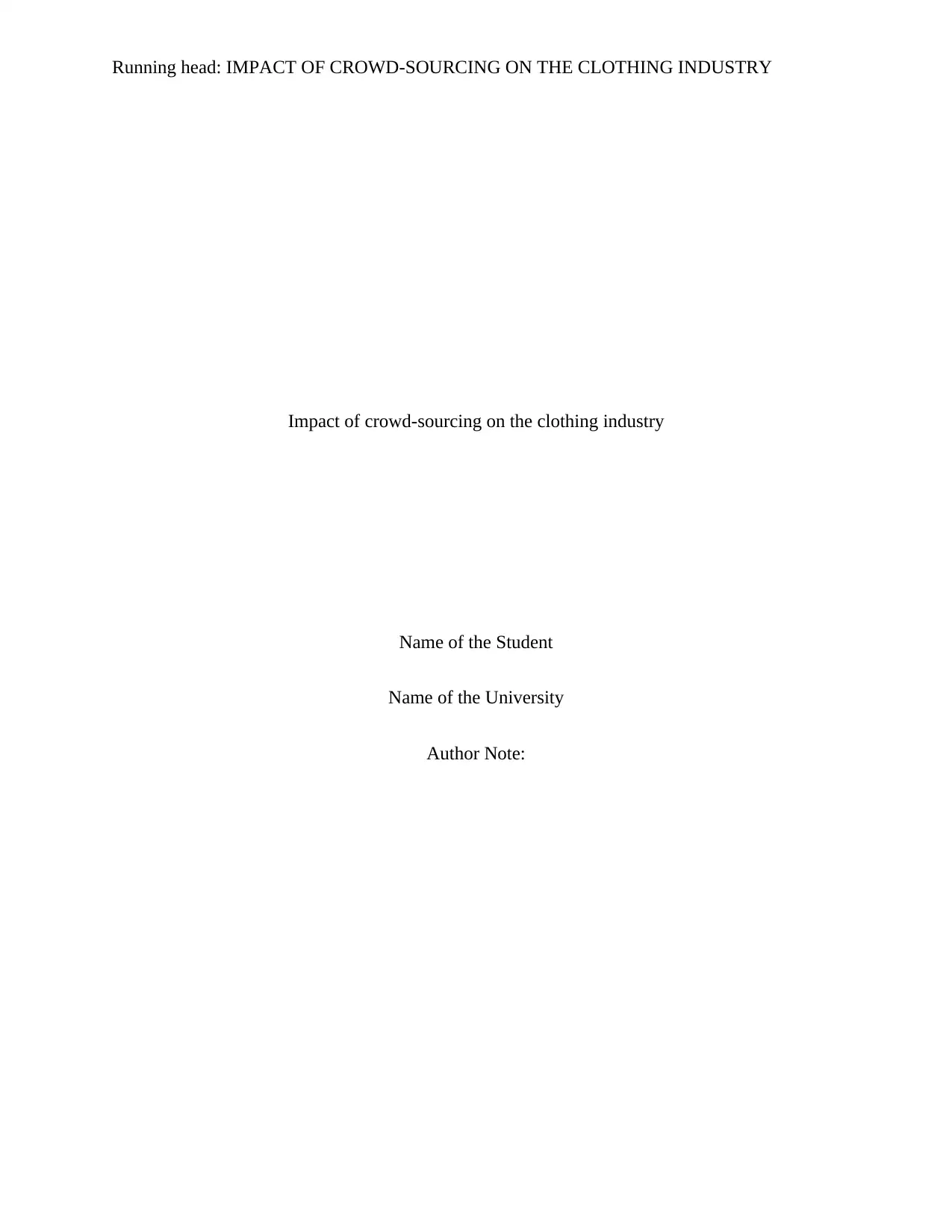
Running head: IMPACT OF CROWD-SOURCING ON THE CLOTHING INDUSTRY
Impact of crowd-sourcing on the clothing industry
Name of the Student
Name of the University
Author Note:
Impact of crowd-sourcing on the clothing industry
Name of the Student
Name of the University
Author Note:
Paraphrase This Document
Need a fresh take? Get an instant paraphrase of this document with our AI Paraphraser
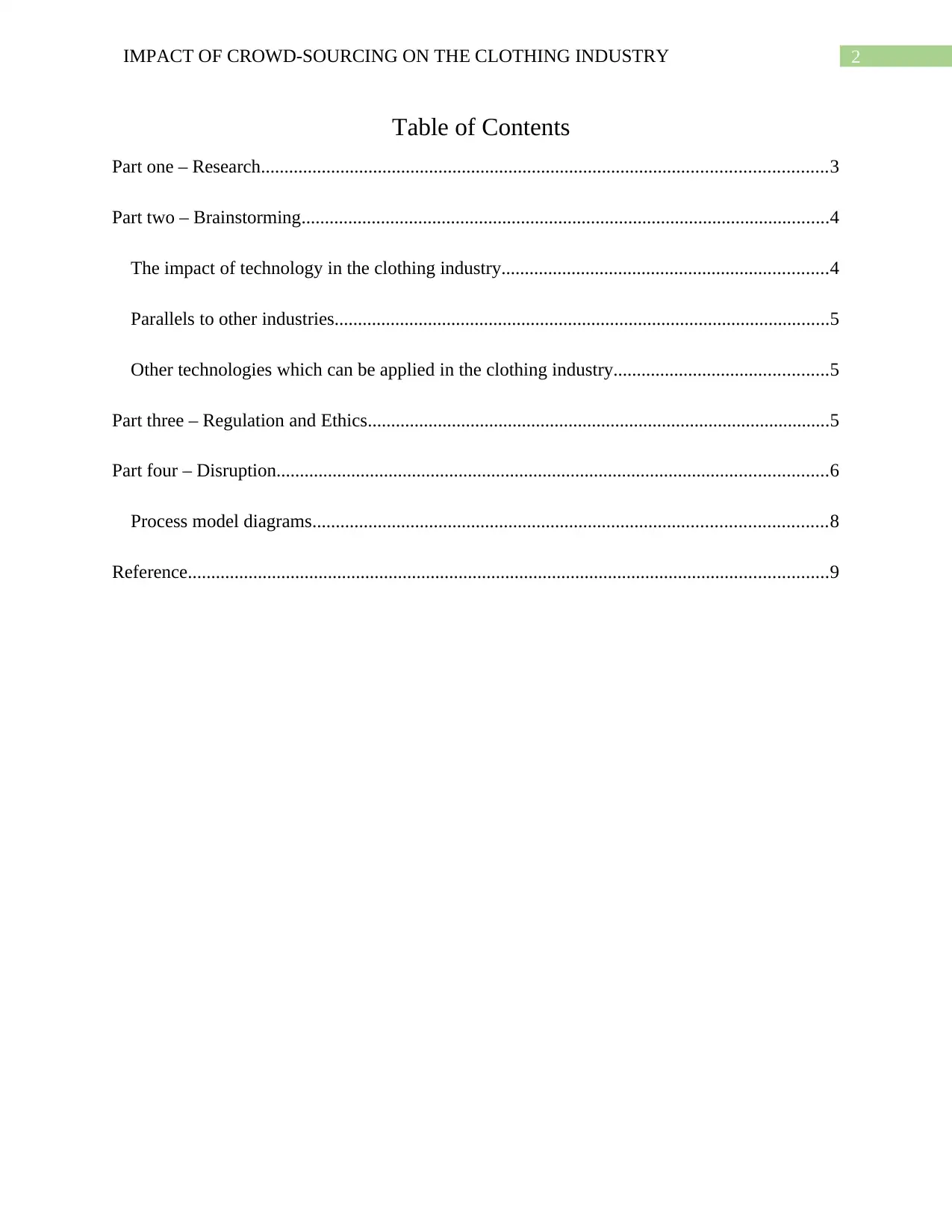
2IMPACT OF CROWD-SOURCING ON THE CLOTHING INDUSTRY
Table of Contents
Part one – Research.........................................................................................................................3
Part two – Brainstorming.................................................................................................................4
The impact of technology in the clothing industry......................................................................4
Parallels to other industries..........................................................................................................5
Other technologies which can be applied in the clothing industry..............................................5
Part three – Regulation and Ethics...................................................................................................5
Part four – Disruption......................................................................................................................6
Process model diagrams..............................................................................................................8
Reference.........................................................................................................................................9
Table of Contents
Part one – Research.........................................................................................................................3
Part two – Brainstorming.................................................................................................................4
The impact of technology in the clothing industry......................................................................4
Parallels to other industries..........................................................................................................5
Other technologies which can be applied in the clothing industry..............................................5
Part three – Regulation and Ethics...................................................................................................5
Part four – Disruption......................................................................................................................6
Process model diagrams..............................................................................................................8
Reference.........................................................................................................................................9

3IMPACT OF CROWD-SOURCING ON THE CLOTHING INDUSTRY
Part one – Research
Technology
Crowdsourcing is defined as the category of technology which can be useful for
providing good quality services to the manufacturing industries such as the clothing industry.
The wide range of industries can be benefitted from the use of this technology (Vickers, 2017).
The evolution of the different technologies such as the Crowdsourcing technology is very much
beneficial for all the manufacturing industries so that they can understand the needs and
requirements of their consumers who are the prime stakeholders of the business (Shang et al.,
2018). Public organizations are hugely benefitted with this technology as have the capability to
understand the needs of the consumers and implement business strategies to fulfill their wish.
The overhead costs of the manufacturing industries can be minimized with the help of the
Crowdsourcing technology. Speed of delivery of products and services of the manufacturing
industries can also be increased with the help of the Crowdsourcing technology (Sampaio et al.,
2019). Flexibility among all the stakeholders of the project is a very concerning factor regarding
getting the desired results from this technology (Zhou et al., 2015). Scalability and diversity are
the other business perspectives of this technology which are increasingly been used in the
manufacturing industries such as the clothing industry.
Industry
The clothing industry is defined as the type of industry which provides exclusive service
to their consumers in the form of life chain and production of garments, production of fur, wool
and cotton of the textile industry, second hand clothes and the recycled products (Goodman &
Paolacci, 2017). The equipment’s of this industry such as the sewing machines and the
Part one – Research
Technology
Crowdsourcing is defined as the category of technology which can be useful for
providing good quality services to the manufacturing industries such as the clothing industry.
The wide range of industries can be benefitted from the use of this technology (Vickers, 2017).
The evolution of the different technologies such as the Crowdsourcing technology is very much
beneficial for all the manufacturing industries so that they can understand the needs and
requirements of their consumers who are the prime stakeholders of the business (Shang et al.,
2018). Public organizations are hugely benefitted with this technology as have the capability to
understand the needs of the consumers and implement business strategies to fulfill their wish.
The overhead costs of the manufacturing industries can be minimized with the help of the
Crowdsourcing technology. Speed of delivery of products and services of the manufacturing
industries can also be increased with the help of the Crowdsourcing technology (Sampaio et al.,
2019). Flexibility among all the stakeholders of the project is a very concerning factor regarding
getting the desired results from this technology (Zhou et al., 2015). Scalability and diversity are
the other business perspectives of this technology which are increasingly been used in the
manufacturing industries such as the clothing industry.
Industry
The clothing industry is defined as the type of industry which provides exclusive service
to their consumers in the form of life chain and production of garments, production of fur, wool
and cotton of the textile industry, second hand clothes and the recycled products (Goodman &
Paolacci, 2017). The equipment’s of this industry such as the sewing machines and the
⊘ This is a preview!⊘
Do you want full access?
Subscribe today to unlock all pages.

Trusted by 1+ million students worldwide
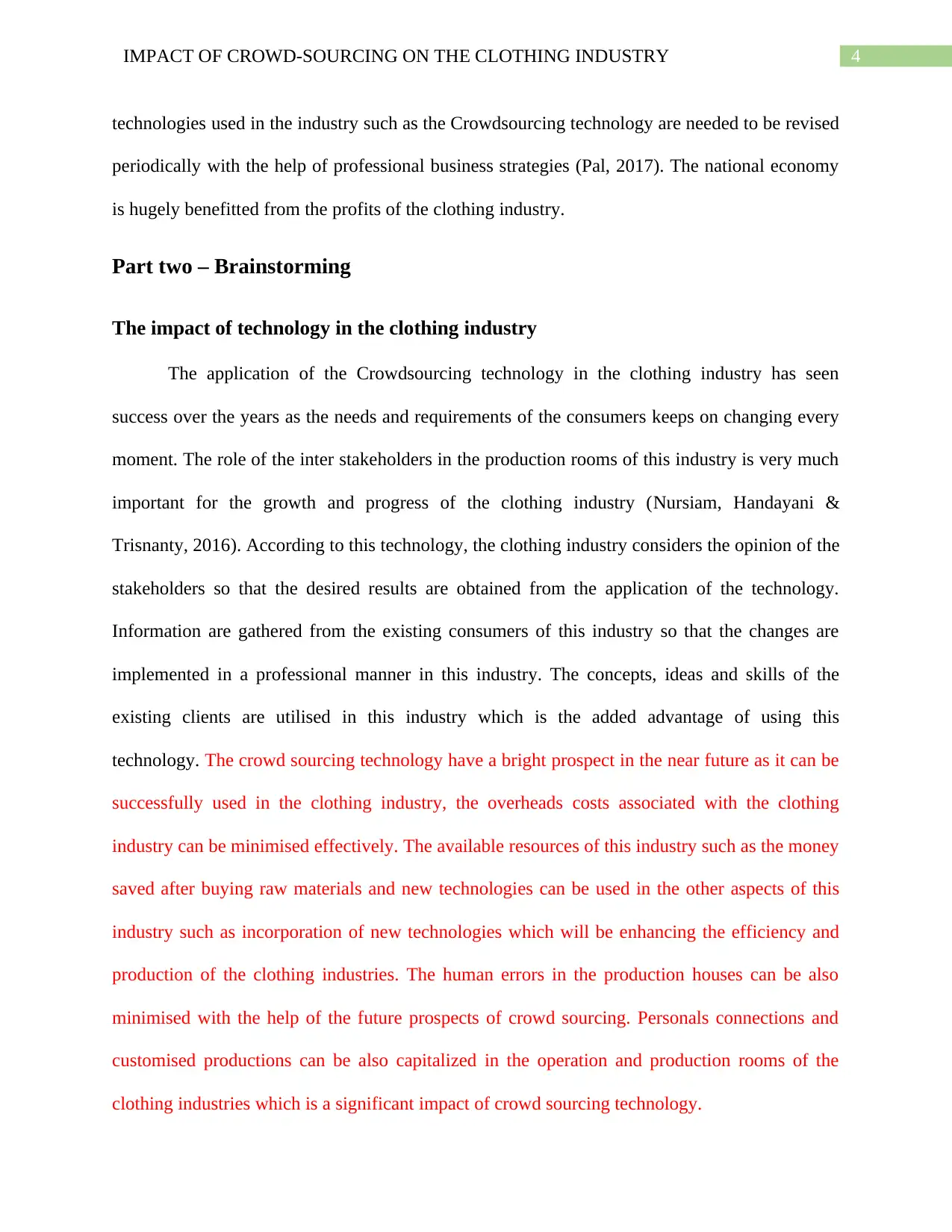
4IMPACT OF CROWD-SOURCING ON THE CLOTHING INDUSTRY
technologies used in the industry such as the Crowdsourcing technology are needed to be revised
periodically with the help of professional business strategies (Pal, 2017). The national economy
is hugely benefitted from the profits of the clothing industry.
Part two – Brainstorming
The impact of technology in the clothing industry
The application of the Crowdsourcing technology in the clothing industry has seen
success over the years as the needs and requirements of the consumers keeps on changing every
moment. The role of the inter stakeholders in the production rooms of this industry is very much
important for the growth and progress of the clothing industry (Nursiam, Handayani &
Trisnanty, 2016). According to this technology, the clothing industry considers the opinion of the
stakeholders so that the desired results are obtained from the application of the technology.
Information are gathered from the existing consumers of this industry so that the changes are
implemented in a professional manner in this industry. The concepts, ideas and skills of the
existing clients are utilised in this industry which is the added advantage of using this
technology. The crowd sourcing technology have a bright prospect in the near future as it can be
successfully used in the clothing industry, the overheads costs associated with the clothing
industry can be minimised effectively. The available resources of this industry such as the money
saved after buying raw materials and new technologies can be used in the other aspects of this
industry such as incorporation of new technologies which will be enhancing the efficiency and
production of the clothing industries. The human errors in the production houses can be also
minimised with the help of the future prospects of crowd sourcing. Personals connections and
customised productions can be also capitalized in the operation and production rooms of the
clothing industries which is a significant impact of crowd sourcing technology.
technologies used in the industry such as the Crowdsourcing technology are needed to be revised
periodically with the help of professional business strategies (Pal, 2017). The national economy
is hugely benefitted from the profits of the clothing industry.
Part two – Brainstorming
The impact of technology in the clothing industry
The application of the Crowdsourcing technology in the clothing industry has seen
success over the years as the needs and requirements of the consumers keeps on changing every
moment. The role of the inter stakeholders in the production rooms of this industry is very much
important for the growth and progress of the clothing industry (Nursiam, Handayani &
Trisnanty, 2016). According to this technology, the clothing industry considers the opinion of the
stakeholders so that the desired results are obtained from the application of the technology.
Information are gathered from the existing consumers of this industry so that the changes are
implemented in a professional manner in this industry. The concepts, ideas and skills of the
existing clients are utilised in this industry which is the added advantage of using this
technology. The crowd sourcing technology have a bright prospect in the near future as it can be
successfully used in the clothing industry, the overheads costs associated with the clothing
industry can be minimised effectively. The available resources of this industry such as the money
saved after buying raw materials and new technologies can be used in the other aspects of this
industry such as incorporation of new technologies which will be enhancing the efficiency and
production of the clothing industries. The human errors in the production houses can be also
minimised with the help of the future prospects of crowd sourcing. Personals connections and
customised productions can be also capitalized in the operation and production rooms of the
clothing industries which is a significant impact of crowd sourcing technology.
Paraphrase This Document
Need a fresh take? Get an instant paraphrase of this document with our AI Paraphraser
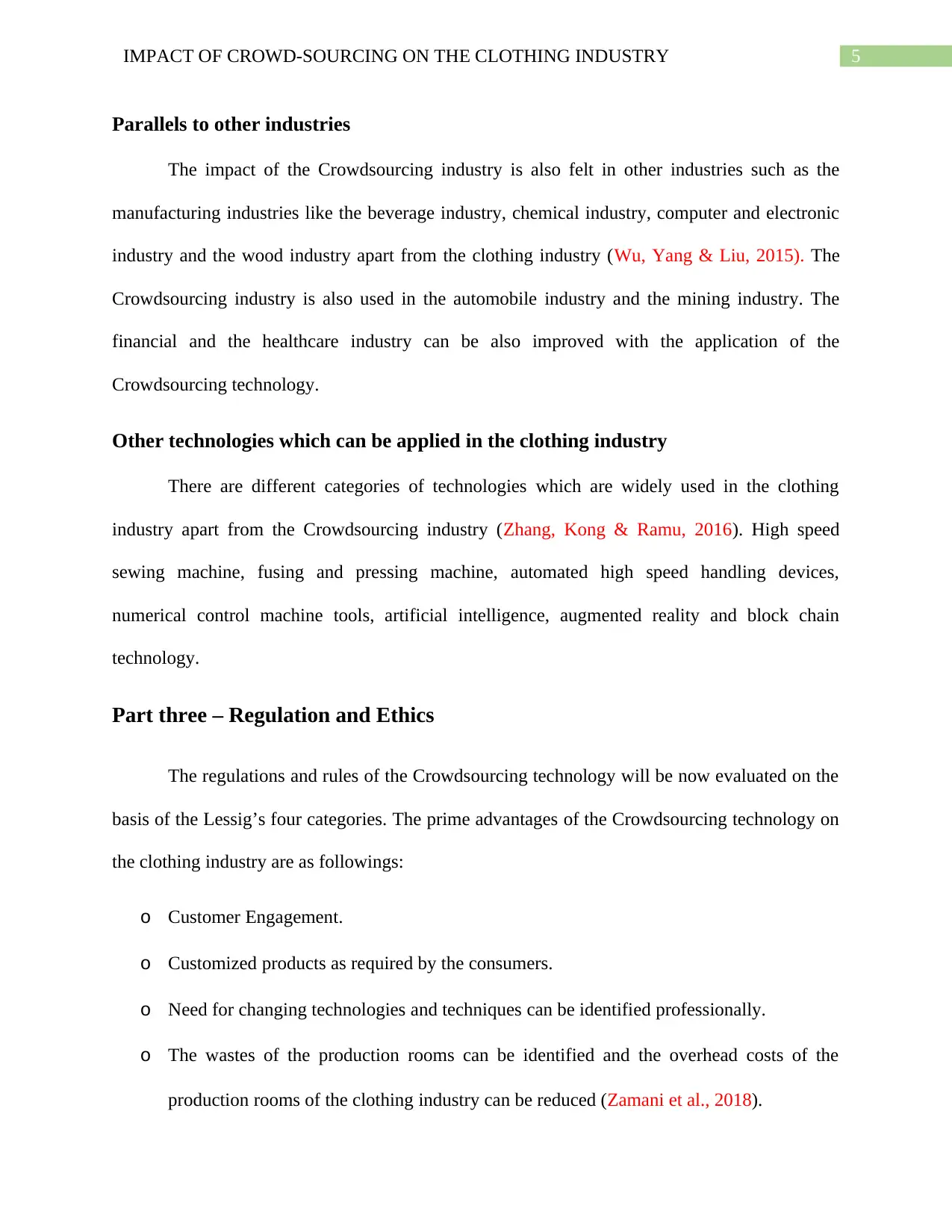
5IMPACT OF CROWD-SOURCING ON THE CLOTHING INDUSTRY
Parallels to other industries
The impact of the Crowdsourcing industry is also felt in other industries such as the
manufacturing industries like the beverage industry, chemical industry, computer and electronic
industry and the wood industry apart from the clothing industry (Wu, Yang & Liu, 2015). The
Crowdsourcing industry is also used in the automobile industry and the mining industry. The
financial and the healthcare industry can be also improved with the application of the
Crowdsourcing technology.
Other technologies which can be applied in the clothing industry
There are different categories of technologies which are widely used in the clothing
industry apart from the Crowdsourcing industry (Zhang, Kong & Ramu, 2016). High speed
sewing machine, fusing and pressing machine, automated high speed handling devices,
numerical control machine tools, artificial intelligence, augmented reality and block chain
technology.
Part three – Regulation and Ethics
The regulations and rules of the Crowdsourcing technology will be now evaluated on the
basis of the Lessig’s four categories. The prime advantages of the Crowdsourcing technology on
the clothing industry are as followings:
o Customer Engagement.
o Customized products as required by the consumers.
o Need for changing technologies and techniques can be identified professionally.
o The wastes of the production rooms can be identified and the overhead costs of the
production rooms of the clothing industry can be reduced (Zamani et al., 2018).
Parallels to other industries
The impact of the Crowdsourcing industry is also felt in other industries such as the
manufacturing industries like the beverage industry, chemical industry, computer and electronic
industry and the wood industry apart from the clothing industry (Wu, Yang & Liu, 2015). The
Crowdsourcing industry is also used in the automobile industry and the mining industry. The
financial and the healthcare industry can be also improved with the application of the
Crowdsourcing technology.
Other technologies which can be applied in the clothing industry
There are different categories of technologies which are widely used in the clothing
industry apart from the Crowdsourcing industry (Zhang, Kong & Ramu, 2016). High speed
sewing machine, fusing and pressing machine, automated high speed handling devices,
numerical control machine tools, artificial intelligence, augmented reality and block chain
technology.
Part three – Regulation and Ethics
The regulations and rules of the Crowdsourcing technology will be now evaluated on the
basis of the Lessig’s four categories. The prime advantages of the Crowdsourcing technology on
the clothing industry are as followings:
o Customer Engagement.
o Customized products as required by the consumers.
o Need for changing technologies and techniques can be identified professionally.
o The wastes of the production rooms can be identified and the overhead costs of the
production rooms of the clothing industry can be reduced (Zamani et al., 2018).
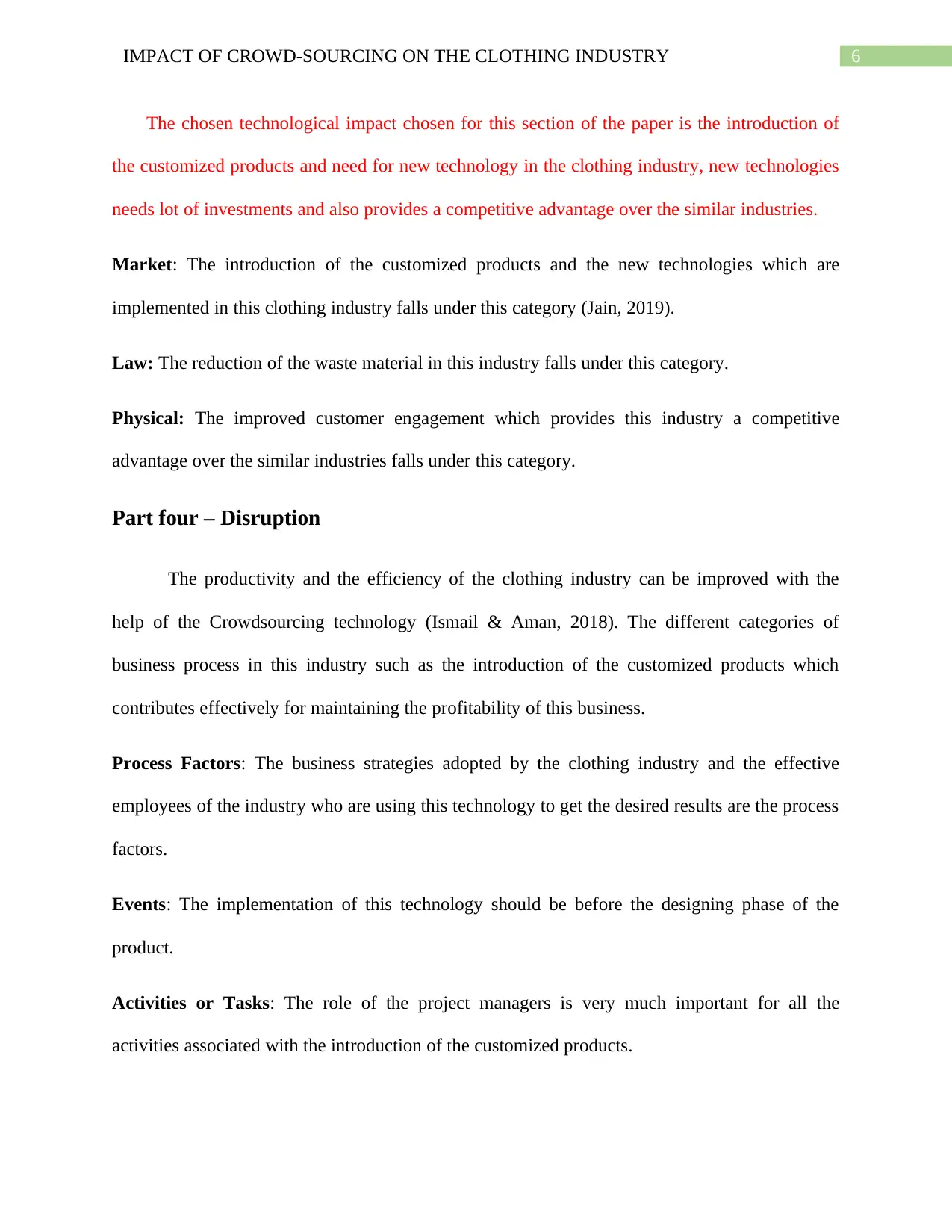
6IMPACT OF CROWD-SOURCING ON THE CLOTHING INDUSTRY
The chosen technological impact chosen for this section of the paper is the introduction of
the customized products and need for new technology in the clothing industry, new technologies
needs lot of investments and also provides a competitive advantage over the similar industries.
Market: The introduction of the customized products and the new technologies which are
implemented in this clothing industry falls under this category (Jain, 2019).
Law: The reduction of the waste material in this industry falls under this category.
Physical: The improved customer engagement which provides this industry a competitive
advantage over the similar industries falls under this category.
Part four – Disruption
The productivity and the efficiency of the clothing industry can be improved with the
help of the Crowdsourcing technology (Ismail & Aman, 2018). The different categories of
business process in this industry such as the introduction of the customized products which
contributes effectively for maintaining the profitability of this business.
Process Factors: The business strategies adopted by the clothing industry and the effective
employees of the industry who are using this technology to get the desired results are the process
factors.
Events: The implementation of this technology should be before the designing phase of the
product.
Activities or Tasks: The role of the project managers is very much important for all the
activities associated with the introduction of the customized products.
The chosen technological impact chosen for this section of the paper is the introduction of
the customized products and need for new technology in the clothing industry, new technologies
needs lot of investments and also provides a competitive advantage over the similar industries.
Market: The introduction of the customized products and the new technologies which are
implemented in this clothing industry falls under this category (Jain, 2019).
Law: The reduction of the waste material in this industry falls under this category.
Physical: The improved customer engagement which provides this industry a competitive
advantage over the similar industries falls under this category.
Part four – Disruption
The productivity and the efficiency of the clothing industry can be improved with the
help of the Crowdsourcing technology (Ismail & Aman, 2018). The different categories of
business process in this industry such as the introduction of the customized products which
contributes effectively for maintaining the profitability of this business.
Process Factors: The business strategies adopted by the clothing industry and the effective
employees of the industry who are using this technology to get the desired results are the process
factors.
Events: The implementation of this technology should be before the designing phase of the
product.
Activities or Tasks: The role of the project managers is very much important for all the
activities associated with the introduction of the customized products.
⊘ This is a preview!⊘
Do you want full access?
Subscribe today to unlock all pages.

Trusted by 1+ million students worldwide
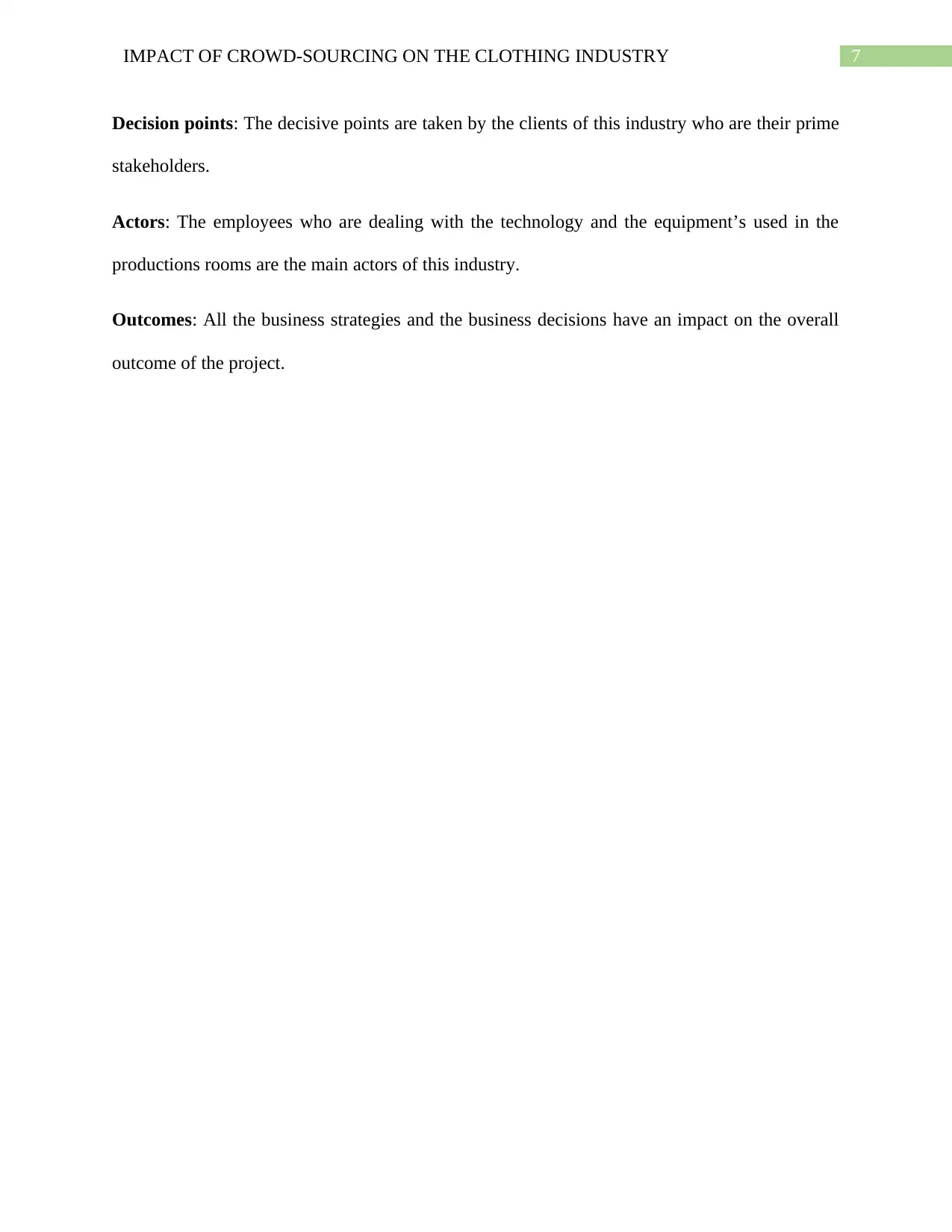
7IMPACT OF CROWD-SOURCING ON THE CLOTHING INDUSTRY
Decision points: The decisive points are taken by the clients of this industry who are their prime
stakeholders.
Actors: The employees who are dealing with the technology and the equipment’s used in the
productions rooms are the main actors of this industry.
Outcomes: All the business strategies and the business decisions have an impact on the overall
outcome of the project.
Decision points: The decisive points are taken by the clients of this industry who are their prime
stakeholders.
Actors: The employees who are dealing with the technology and the equipment’s used in the
productions rooms are the main actors of this industry.
Outcomes: All the business strategies and the business decisions have an impact on the overall
outcome of the project.
Paraphrase This Document
Need a fresh take? Get an instant paraphrase of this document with our AI Paraphraser
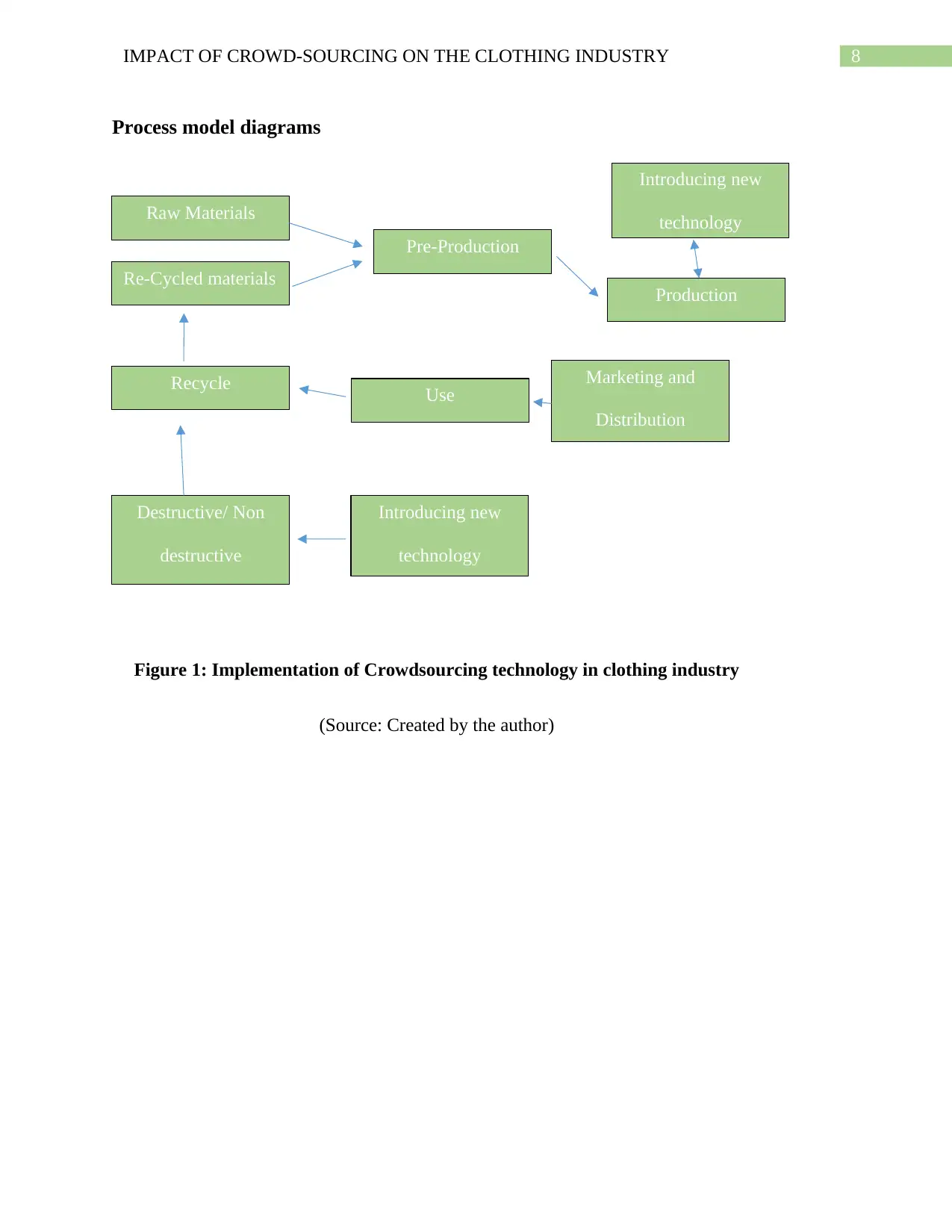
8IMPACT OF CROWD-SOURCING ON THE CLOTHING INDUSTRY
Process model diagrams
Figure 1: Implementation of Crowdsourcing technology in clothing industry
(Source: Created by the author)
Raw Materials
Re-Cycled materials
Pre-Production
Production
Introducing new
technology
Recycle
Destructive/ Non
destructive
Use
Introducing new
technology
Marketing and
Distribution
Process model diagrams
Figure 1: Implementation of Crowdsourcing technology in clothing industry
(Source: Created by the author)
Raw Materials
Re-Cycled materials
Pre-Production
Production
Introducing new
technology
Recycle
Destructive/ Non
destructive
Use
Introducing new
technology
Marketing and
Distribution
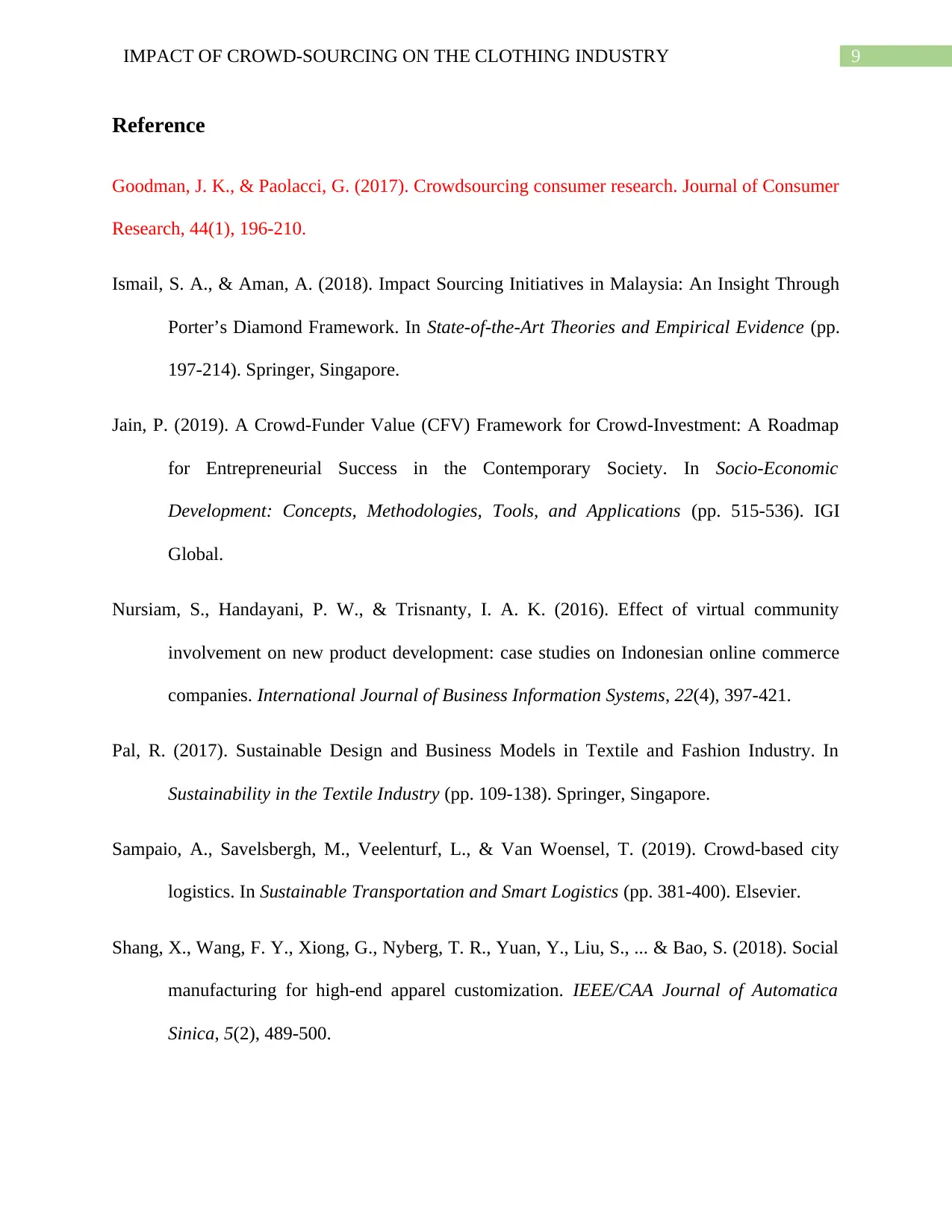
9IMPACT OF CROWD-SOURCING ON THE CLOTHING INDUSTRY
Reference
Goodman, J. K., & Paolacci, G. (2017). Crowdsourcing consumer research. Journal of Consumer
Research, 44(1), 196-210.
Ismail, S. A., & Aman, A. (2018). Impact Sourcing Initiatives in Malaysia: An Insight Through
Porter’s Diamond Framework. In State-of-the-Art Theories and Empirical Evidence (pp.
197-214). Springer, Singapore.
Jain, P. (2019). A Crowd-Funder Value (CFV) Framework for Crowd-Investment: A Roadmap
for Entrepreneurial Success in the Contemporary Society. In Socio-Economic
Development: Concepts, Methodologies, Tools, and Applications (pp. 515-536). IGI
Global.
Nursiam, S., Handayani, P. W., & Trisnanty, I. A. K. (2016). Effect of virtual community
involvement on new product development: case studies on Indonesian online commerce
companies. International Journal of Business Information Systems, 22(4), 397-421.
Pal, R. (2017). Sustainable Design and Business Models in Textile and Fashion Industry. In
Sustainability in the Textile Industry (pp. 109-138). Springer, Singapore.
Sampaio, A., Savelsbergh, M., Veelenturf, L., & Van Woensel, T. (2019). Crowd-based city
logistics. In Sustainable Transportation and Smart Logistics (pp. 381-400). Elsevier.
Shang, X., Wang, F. Y., Xiong, G., Nyberg, T. R., Yuan, Y., Liu, S., ... & Bao, S. (2018). Social
manufacturing for high-end apparel customization. IEEE/CAA Journal of Automatica
Sinica, 5(2), 489-500.
Reference
Goodman, J. K., & Paolacci, G. (2017). Crowdsourcing consumer research. Journal of Consumer
Research, 44(1), 196-210.
Ismail, S. A., & Aman, A. (2018). Impact Sourcing Initiatives in Malaysia: An Insight Through
Porter’s Diamond Framework. In State-of-the-Art Theories and Empirical Evidence (pp.
197-214). Springer, Singapore.
Jain, P. (2019). A Crowd-Funder Value (CFV) Framework for Crowd-Investment: A Roadmap
for Entrepreneurial Success in the Contemporary Society. In Socio-Economic
Development: Concepts, Methodologies, Tools, and Applications (pp. 515-536). IGI
Global.
Nursiam, S., Handayani, P. W., & Trisnanty, I. A. K. (2016). Effect of virtual community
involvement on new product development: case studies on Indonesian online commerce
companies. International Journal of Business Information Systems, 22(4), 397-421.
Pal, R. (2017). Sustainable Design and Business Models in Textile and Fashion Industry. In
Sustainability in the Textile Industry (pp. 109-138). Springer, Singapore.
Sampaio, A., Savelsbergh, M., Veelenturf, L., & Van Woensel, T. (2019). Crowd-based city
logistics. In Sustainable Transportation and Smart Logistics (pp. 381-400). Elsevier.
Shang, X., Wang, F. Y., Xiong, G., Nyberg, T. R., Yuan, Y., Liu, S., ... & Bao, S. (2018). Social
manufacturing for high-end apparel customization. IEEE/CAA Journal of Automatica
Sinica, 5(2), 489-500.
⊘ This is a preview!⊘
Do you want full access?
Subscribe today to unlock all pages.

Trusted by 1+ million students worldwide

10IMPACT OF CROWD-SOURCING ON THE CLOTHING INDUSTRY
Vickers, A. (2017). Clothing Production in Indonesia: A Divided Industry. Institutions and
Economies, 41-60.
Wu, C., Yang, Z., & Liu, Y. (2015). Smartphones based crowdsourcing for indoor localization.
IEEE Transactions on Mobile Computing, 14(2), 444-457.
Zamani, B., Sandin, G., Svanström, M., & Peters, G. M. (2018). Hotspot identification in the
clothing industry using social life cycle assessment—opportunities and challenges of
input-output modelling. The International Journal of Life Cycle Assessment, 23(3), 536-
546.
Zhang, M., Kong, X. X., & Ramu, S. C. (2016). The transformation of the clothing industry in
China. Asia Pacific Business Review, 22(1), 86-109.
Zhou, D., Liu, Q., Platt, J. C., Meek, C., & Shah, N. B. (2015). Regularized minimax conditional
entropy for crowdsourcing. arXiv preprint arXiv:1503.07240.
Vickers, A. (2017). Clothing Production in Indonesia: A Divided Industry. Institutions and
Economies, 41-60.
Wu, C., Yang, Z., & Liu, Y. (2015). Smartphones based crowdsourcing for indoor localization.
IEEE Transactions on Mobile Computing, 14(2), 444-457.
Zamani, B., Sandin, G., Svanström, M., & Peters, G. M. (2018). Hotspot identification in the
clothing industry using social life cycle assessment—opportunities and challenges of
input-output modelling. The International Journal of Life Cycle Assessment, 23(3), 536-
546.
Zhang, M., Kong, X. X., & Ramu, S. C. (2016). The transformation of the clothing industry in
China. Asia Pacific Business Review, 22(1), 86-109.
Zhou, D., Liu, Q., Platt, J. C., Meek, C., & Shah, N. B. (2015). Regularized minimax conditional
entropy for crowdsourcing. arXiv preprint arXiv:1503.07240.
1 out of 10
Related Documents
Your All-in-One AI-Powered Toolkit for Academic Success.
+13062052269
info@desklib.com
Available 24*7 on WhatsApp / Email
![[object Object]](/_next/static/media/star-bottom.7253800d.svg)
Unlock your academic potential
Copyright © 2020–2025 A2Z Services. All Rights Reserved. Developed and managed by ZUCOL.





